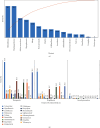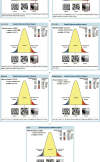Regional Cross-Sectional Based Study and Associated Risk Factors of Porcine Circovirus 2 in Nigerian Pigs
- PMID: 40303722
- PMCID: PMC12017129
- DOI: 10.1155/2023/9201177
Regional Cross-Sectional Based Study and Associated Risk Factors of Porcine Circovirus 2 in Nigerian Pigs
Erratum in
-
Corrigendum to "Regional Cross-Sectional Based Study and Associated Risk Factors of Porcine Circovirus 2 in Nigerian Pigs".Transbound Emerg Dis. 2025 Aug 11;2025:9890640. doi: 10.1155/tbed/9890640. eCollection 2025. Transbound Emerg Dis. 2025. PMID: 40832124 Free PMC article.
Abstract
Porcine circovirus 2 (PCV2) is a swine viral pathogen of substantial economic importance in pig farming globally. However, large-scale surveillance is needed to determine its prevalence and associated risk factors in the Nigerian pigs. We conducted molecular-based surveillance and mapping of PCV2 in southwest Nigeria to assess its prevalence and spatiality. Six hundred forty-eight individual fecal samples were collected from the different age groups of pigs from 67 farms in three southwest states. The polymerase chain reaction technique was used to screen the samples with a specific primer pair. The viral prevalence was determined at individual animal and farm levels. Overall, 145 out of 648 samples (22.4%) and 49/67 farms (73.1%) tested positive for PCV2. The highest prevalence of PCV2 was observed in Oyo State (63/185, 34.1%) and in growers (66/145, 45.5%). Restricting visitors' entrance to the farm was found to be strongly protective for PCV2 (AOR 0.122; p=0.007; 95% CI; 0.027-0.564), while not having a quarantine protocol (AOR 4.445; p=0.041; 95% CI; 1.067-18.5280) and reporting coccidiosis as a common disease encountered (AOR 14.340; p=0.007; 95% CI; 2.094-98.203) on the farm were significant risk factors identified to be associated with the presence of PCV2. This study revealed a higher prevalence of PCV2 in Nigerian swine herds than expected and presented significant spatial clustering of infection in the studied region. It has also highlighted the risk factors driving its spread in the studied area. The research findings underscore the need for a policy decision to promote PCV2 vaccination in the country, which is currently not in place. The availability and use of the PCV2 vaccines, in addition to effective biosecurity measures, will help to mitigate the virus and its associated diseases in the country for sustainable and profitable pig farming, which holds vast potential in solving the problem of hunger and poverty.
Copyright © 2023 Kayode O. Afolabi et al.
Conflict of interest statement
The authors declare that there is no competing interest regarding the publication of this paper.
Figures





References
-
- Segalés J., Allan G. M., Domingo M. Diseases of Swine . John Wiley & Sons, Ltd.; 2019. Circoviruses; pp. 473–487. - DOI
-
- Biagini P., Bendinelli M., Hino S., et al. Classification and Nomenclature of Viruses: Ninth Report of the International Committee on the Taxonomy of Viruses . London: Elsevier Academic Press; 2011. Circoviridae. Virus taxonomy; pp. 343–349.
MeSH terms
LinkOut - more resources
Full Text Sources

